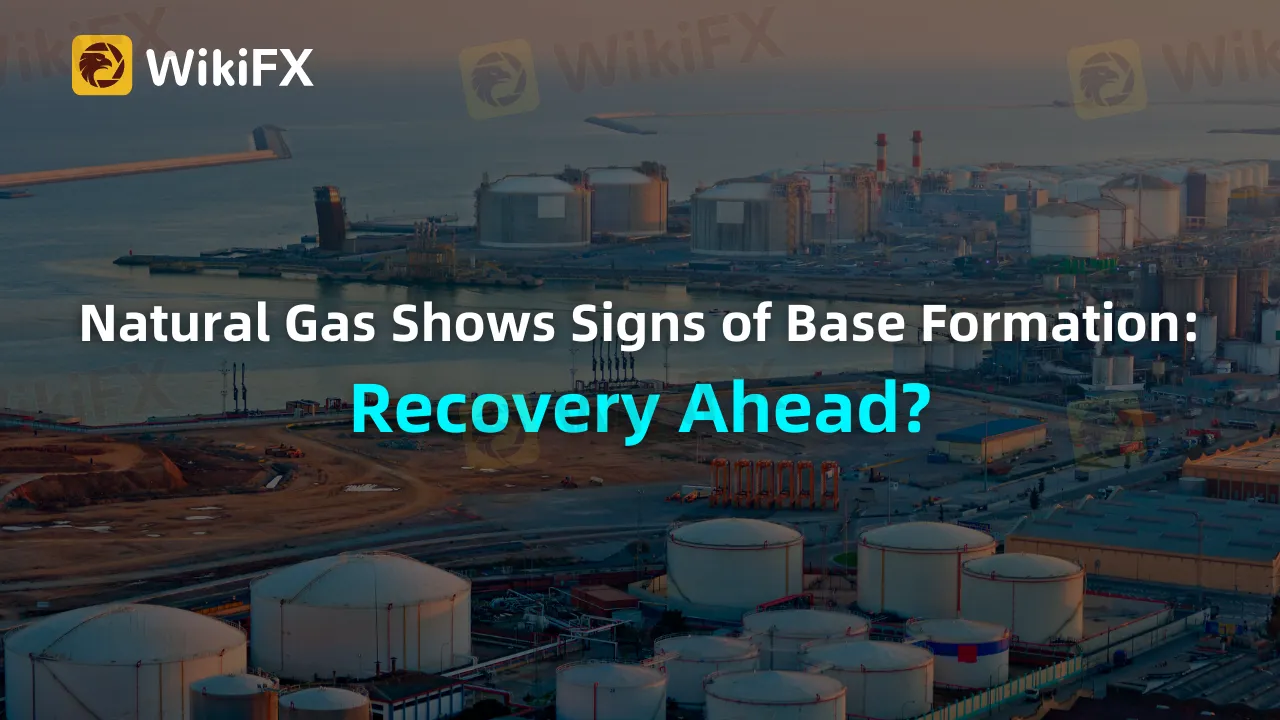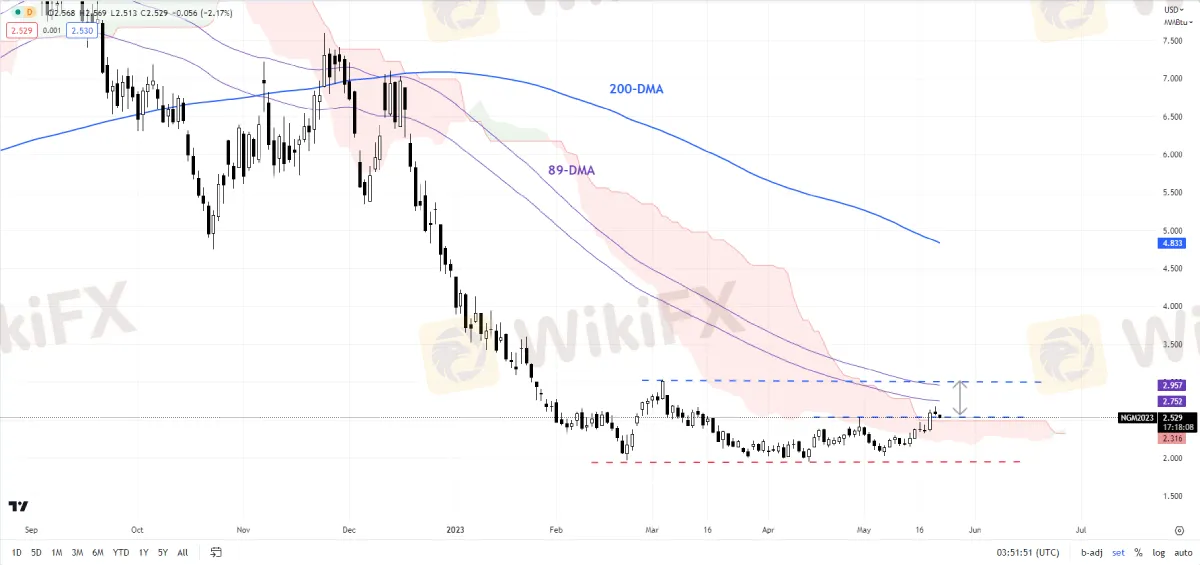简体中文
繁體中文
English
Pусский
日本語
ภาษาไทย
Tiếng Việt
Bahasa Indonesia
Español
हिन्दी
Filippiiniläinen
Français
Deutsch
Português
Türkçe
한국어
العربية
Natural Gas Shows Signs of Base Formation: Recovery Ahead?
Abstract:The recent increase in natural gas prices suggests a potential recovery, but setbacks are possible. Factors include reduced Canadian gas exports due to wildfires, lower wind power generation, and decreased drilling activity. Technical analysis indicates resistance levels and diminishing downward pressure. Maintaining support above 2.03 is crucial for sustained upward movement.

The recent surge in momentum observed in the natural gas market could indicate the beginning of a potential recovery after a prolonged period of weakness. However, it is important to note that the decline experienced over the past year suggests that any upward movement in prices might be accompanied by setbacks, rather than a continuous rise. One of the factors contributing to the recent boost in natural gas prices is the reduced gas exports from Canada, primarily caused by wildfires in Alberta and other western provinces. Additionally, the decrease in wind power generation last week led to higher utilization of natural gas for electricity production, further supporting the prices.
Furthermore, the decline in drilling activity due to oversupply conditions and stricter credit conditions makes it less likely for natural gas prices to experience a significant further decline. The United States Energy Information Administration's Short-term Energy Outlook anticipates that the U.S. natural gas spot price will increase towards 3.71 by December.
Natural Gas Daily Chart

From a technical analysis perspective, natural gas is currently attempting to surpass a crucial resistance level at the April high of 2.52, which aligns with the upper boundary of the Ichimoku channel on the daily charts. A successful breakout above this level could potentially pave the way for further upward movement toward the March high of 3.03. However, it should be noted that overcoming this level might prove challenging, at least initially.

On the whole, the downward pressure on natural gas prices seems to be diminishing, as suggested by the color-coded candlestick charts that utilize trending and momentum indicators. Moreover, market diversity has been at exceptionally low levels, indicating a potential shift in market dynamics. These observations are consistent with the analysis presented in the articles titled “Natural Gas Price Setup: Downward Pressure is Abating,” published on April 11, and “Natural Gas Price Rebound Could Extend; What's Next for Crude Oil?” published on May 18.
Natural Gas Monthly Chart

To maintain the short-term upward pressure, it is crucial for natural gas prices to remain above the support level established in early May at 2.03. A decline below this support level would increase the risk of a renewed downward movement in prices.
Note: The color-coded chart mentioned in the article is designed to visually represent the prevailing trend in natural gas prices. Blue candles indicate a bullish phase, red candles indicate a bearish phase and grey candles represent consolidation phases that can occur within both bullish and bearish trends, sometimes appearing towards the end of a trend. It should be noted that the candle color is not predictive and may change in the subsequent bar. False patterns can also occur around the 200-period moving average, support/resistance levels, and in sideways or choppy markets. The author does not guarantee the accuracy of the information provided, and past performance should not be considered indicative of future performance. Users should exercise caution and make their own decisions when using this information, as they assume any associated risks.
Download and install the WikiFX App on your smartphone to stay updated on the latest news.
Download the App here: https://social1.onelink.me/QgET/px2b7i8n

Disclaimer:
The views in this article only represent the author's personal views, and do not constitute investment advice on this platform. This platform does not guarantee the accuracy, completeness and timeliness of the information in the article, and will not be liable for any loss caused by the use of or reliance on the information in the article.
Read more

Webull and Others Fined $275,000 for Incomplete Suspicious Activity Reports
Webull Financial, alongside Lightspeed Financial Services Group and Paulson Investment Company, LLC, has agreed to pay a collective fine of $275,000 following an investigation by the US Securities and Exchange Commission (SEC). The penalty was issued due to the firms’ failure to include essential information in suspicious activity reports (SARs) over a four-year period.

Barclays Resolves £40M Fine Over 2008 Fundraising Disclosure Failures
Barclays has reached a settlement with the UK’s Financial Conduct Authority (FCA), agreeing to pay a £40 million fine for failing to adequately disclose arrangements with Qatari investors during its critical fundraising efforts amidst the 2008 financial crisis.

WikiEXPO Global Expert Interview: Advanced Practices and Insights in Financial Regulation
In the midst of rapid advancements and evolving landscapes in financial technology, financial regulation, and ensuring financial security, WikiGlobal stands at the forefront, closely tracking these transformative trends. As we embark on our series of exclusive interviews focusing on these pivotal areas, we are delighted to have had an in-depth conversation with.

Alleged Concerns with TradeEU.global's Trading Practices
An individual trader has come forward with allegations of an unfavourable experience while using the services of the broker TradeEU.global.
WikiFX Broker
Latest News
Saxo & Portuguese Bank Partnership
SEC Fines Broker-Dealers $275K for Incomplete SAR Filings
Elon Musk Warns of Imminent US Bankruptcy | Bitcoin Retreats from $100K
UK FCA Fines Barclays £40 Million Over 2008 Deal
Justin Sun Invests $30M in Trump-Backed World Liberty Financial
WikiEXPO Global Expert Interview: Advanced Practices and Insights in Financial Regulation
Lured by False Promises: Malaysian Driver Lost RM218K to an Investment Scam
FTX Sets March 2025 Timeline for Creditor Payouts: What It Means for Investors
What is an Economic Calendar? How it works
Pros & Cons of Automated Forex Trading
Currency Calculator


